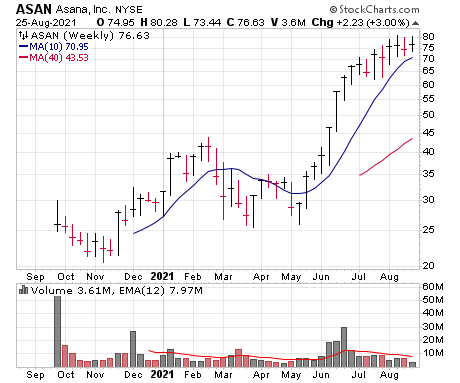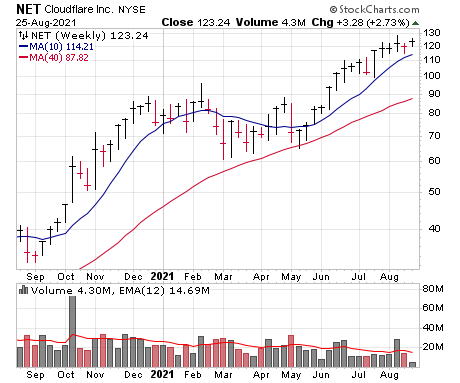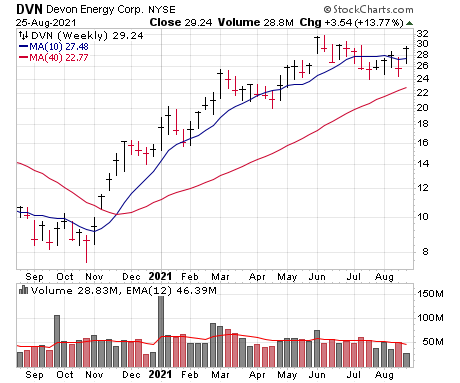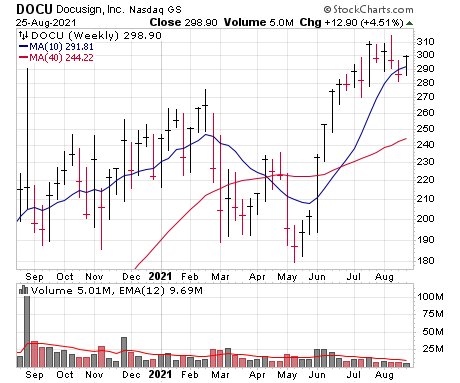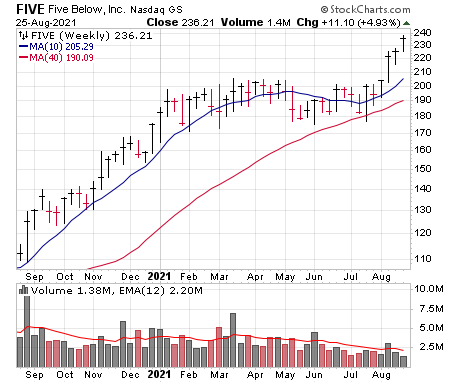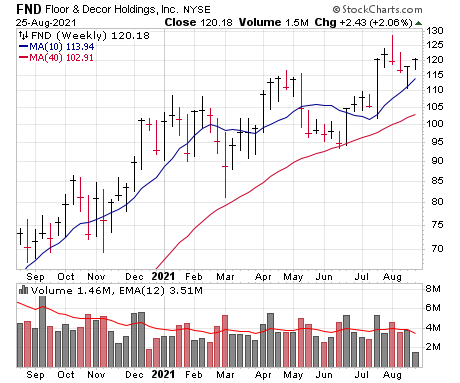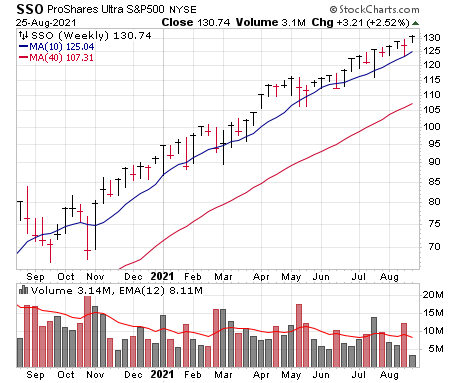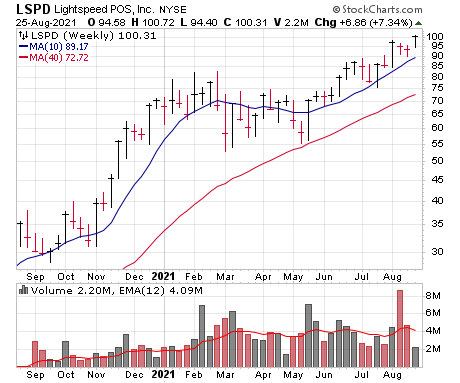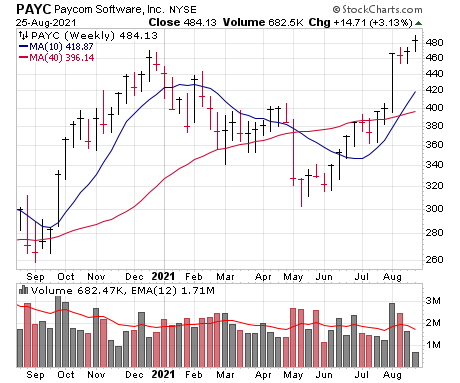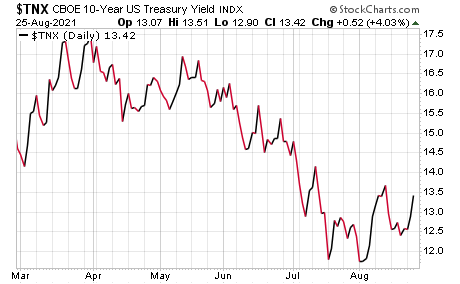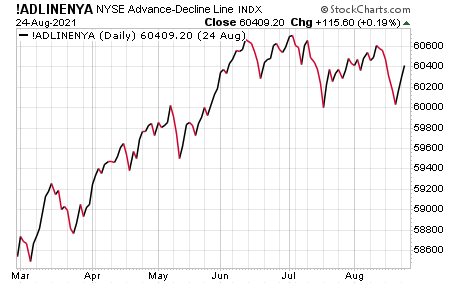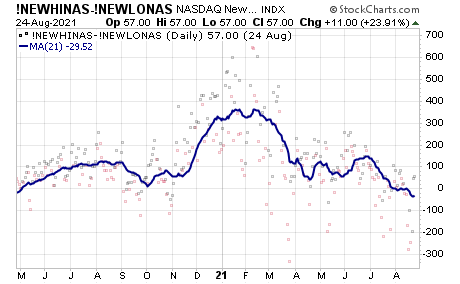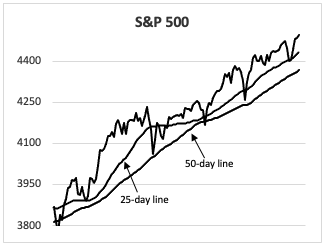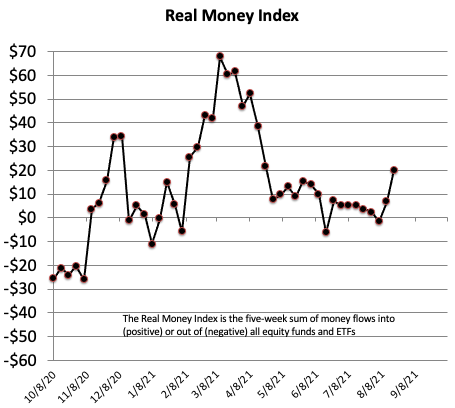Growth stocks went through the wringer for a bit but have again found support and bounced back in recent days. We’ll certainly take it, and we like the way most of our stocks are acting, but it’s too soon to conclude growth stocks have completely escaped the chop that we’ve seen in recent months.
Thus, we’re still going slow, but we are putting a little money to work tonight, filling out our position in one of our holdings.
Elsewhere in tonight’s issue, we write about some of the mixed evidence out there, including divergences (negative) and the recent plunge in rates (a type of blastoff indicator), as well as review all of our stocks and updated watch list.
Cabot Growth Investor 1479
[premium_html_toc post_id="236238"]
Can Growth Break Free
from the Chop (Part II)
Near the end of July, growth stocks had just suffered a big dip earlier that month, with many falling down toward key support areas. But instead of keeling over, many rebounded nicely, including a few leaders that moved to new highs along with some bullish earnings reactions. We were obviously encouraged, and on this page we asked whether, following the shakeout-and-recovery action, growth stocks could finally break free of the multi-month chop.
Today, a month later, we’re asking the same question we did back then: When examining growth-oriented funds and indexes (including the Russell 2000 Growth Fund (IWO), shown here), we’ve now seen five sharp selling waves, including yet another tedious rotation-induced growth stock dip earlier in August. And, as we saw last month, buyers showed up where they “should,” sending many names nicely higher during the past week.
As always, up is better than down, so we’re all for the latest rally. But the question remains: Can growth stocks enter more of a sustained uptrend, with relatively persistent upmoves among leading titles? Or are we going to continue to see money slosh around to different areas every two or three weeks? Or, in a more bearish scenario, are the divergences we’re starting to see a sign that a deeper correction is coming soon? (See more on that later in this issue.)
Stepping back, we still have a good amount of conviction that the market’s next big move is up—whether it’s our Cabot Trend Lines or some other studies, the odds strongly favor higher prices ahead for the overall market and for growth stocks (which have already endured six months of generally sloppy action) six to 12 months out.
But for the here and now, we’re sticking with the same general game plan. We still think it’s best to continue going slow and buying on dips, but are open to changing our mind if we see more footprints of big-investor buying in leading names.
What To Do Now
All in all, we remain optimistic and more bullish than not, though we’re not pushing the envelope. In the Model Portfolio, most stocks are acting well, and tonight we’re going to average up on one of them, buying another half-sized position (5% of the portfolio) in Cloudflare (NET) to fill out our position. Our cash position will now be around 25%.
Model Portfolio Update
The bucking bronco environment continues, with growth stocks suffering through a sour week and a half before the buyers returned in recent days. Don’t get us wrong, the recent action is encouraging, especially as many growth stocks dipped right down to key support—often their 50-day lines or the highs of prior consolidations. In other words, many stocks acted as they “should,” and the fact that some stocks have quickly regained new high ground is obviously a plus.
That said, whether it’s individual stocks or growth-oriented funds and indexes, there’s no evidence yet that growth stocks have finally escaped the chop and rotation, as most names are still hacking around in ranges or doing the four-steps-forward, three-steps-back sort of thing.
We generally like where the Model Portfolio stands, though tonight we’re putting a little more money to work by filling out our position in Cloudflare (NET), buying another half-sized position on this latest dip, leaving us with around 25% in cash.
Current Recommendations
| Stock | No. of Shares | Portfolio Weightings | Price Bought | Date Bought | Price on 8/26/21 | Profit | Rating |
| Asana (ASAN) | 1354 | 5% | 73 | 7/22/21 | 76 | 5% | Buy a Half |
| Cloudflare (NET) | 963 | 6% | 104 | 6/25/21 | 123 | 17% | Buy Another Half |
| Devon Energy (DVN) | 7240 | 9% | 28 | 5/7/21 | 29 | 4% | Hold |
| DocuSign (DOCU) | 682 | 10% | 291 | 6/25/21 | 302 | 4% | Buy |
| Dynatrace (DT) | 3114 | 10% | 65 | 8/6/21 | 67 | 3% | Buy |
| Five Below (FIVE) | 852 | 9% | 138 | 9/18/20 | 226 | 64% | Buy |
| Floor & Décor (FND) | 1,845 | 11% | 111 | 4/9/21 | 119 | 7% | Buy |
| ProShares Ultra S&P 500 (SSO) | 1,741 | 11% | 60 | 5/29/20 | 130 | 117% | Buy |
| CASH | $616,439 | 30% |
Asana (ASAN)—ASAN has lost a little steam this month, with each foray into the 78 to 80 area being rejected and the stock testing its 25-day line for the umpteenth time during its uptrend. That’s a short-term thing to watch, but we’re still placing more emphasis on the fact that the stock’s jaw-dropping post-May advance has so far failed to attract any meaningful selling, which is a rarity in this environment. The real test will come next Wednesday (September 1), when the company will release earnings—analysts see sales up 58%, but the outlook and many sub-metrics (including growth in large customers) will surely be key. If ASAN can get through earnings in decent shape (possibly with a test of its 10-week line thrown in?), we’ll likely look to fill out our position, but let’s wait and see if the stock can hold its own. If you own some, sit tight, and if not, you can pick up a small amount if you’re comfortable with the earnings risk. BUY A HALF
Cloudflare (NET)—Cloudflare continues to act like one of the real growth leaders of the market, and we believe one reason is that it has the biggest hand in two very lucrative cookie jars. First, its offerings allow firms to improve the performance and uptime of their network and various apps (a “very large cryptocurrency exchange” expanded use of the firm’s network to get the fastest possible performance in Q2), which is vital for a ton of industries; and second, it helps protect the network itself, which is attracting tons of new customers, including big enterprises and even Uncle Sam. (The company’s CEO recently talked about how it booked contracts with three old-school manufacturing and industrial supply companies worth more than $1 million in annual spend in Q2—and all came in through word of mouth.) Given that just 19% of the Fortune 1000 are customers, and that current customers are beefing up their use of Cloudflare’s offerings (same-customer revenue growth up 24% in Q2), more investors are coming around to the view that the firm should be able to grow rapidly for years to come. As for the stock, it wouldn’t shock us if it rests or pulls in some after its big post-May run, but the recent advance (including 13 of 14 weeks up) is a strong show of momentum that usually persists. We’ll buy another 5% stake in NET here, filling out our position. BUY ANOTHER HALF
Devon Energy (DVN)—We came very close to dumping DVN last week, which retested its recent lows as oil prices sank (from 70 to about 62) on virus-related fears. But oil prices have since bounced nicely, helping the stock to rally strongly, actually nosing to six-week highs today. In our hearts, we’re optimistic DVN has bottomed and will continue to find support on any future oil weakness given its out-of-this-world cash flow story (FYI, the 49-cent-per-share dividend will be paid September 30 to those who own the stock at the close September 10), but (a) we can’t say shares are totally out of the woods chart-wise, and (b) it’s obvious that the group is still getting tossed around by the daily swing in oil prices. We’re definitely comfortable holding our shares here, and if the stock can stabilize, we could restore our Buy rating. But given the volatile, news-driven action, we’ll stay on Hold for now. HOLD
DocuSign (DOCU)—Like many growth stocks, DOCU has lost some steam of late—net-net, shares really haven’t done much since the end of June, and the recent bounce has been just OK. Still, examining the move since its June earnings-induced blastoff, the stock’s rally from 230 to 315 and retreat to 280 (round numbers) is far from abnormal, and the fact that the stock has held its 50-day line (its first test of that key support area) is a good thing. Similar to ASAN, though, more will be revealed next week—DocuSign’s quarterly report is due out September 2, with sales expected to rise 43% and earnings to come in at 40 cents per share, though the stock will probably move more based on management’s commentary regarding the growth outlook. Right here, the main trend is up, and the story remains as good as ever, so we’re sticking with our Buy rating. BUY
Dynatrace (DT)—DT dipped right to its 50-day line with growth stocks last week, but, like many names we own and are watching, bounced right where it should—and actually pushed to new price highs yesterday. Chart-wise, then, the trend is up, so we’re staying on Buy. Fundamentally, we wanted to cut/paste something we briefly touched on recently but which speaks to the long runway of growth ahead for Dynatrace and its position vs. competition. Here’s the CEO: “A couple of years ago, it felt like [the industry] was a little more competitive than it is today, actually. And one of the big reasons for that is that dynamic multiclouds are the platform of choice, and you can’t just throw old tooling at it any longer. So we see less of the Cisco, AppDynamics, New Relics. We rarely run into a Datadog or a Splunk out there. So it is a massive market. But I think a lot of it is that the problems that we solve for digital transformers, I mean, they have multigenerational technologies. They are quite advanced with cloud, but they connect it back into sort of a hybrid back end, and we’re just uniquely positioned for it. The other thing with the digital transformers, the billion-dollar-plus companies that we target is that they have multiple apps, multiple lines of business. It’s a complex environment. And we shine the greater the complexity. Because that’s what we built the automation and AI for, was for those environments that [have] overwhelming amounts of data, variety, velocity, the amount of change, etc. So in those more complex environments, our combination of capabilities really shine.” We’ll stay on Buy. BUY
Five Below (FIVE)—Patience is usually a virtue in life and in the market, and that’s obviously been the case with Five Below, which has staged a rare (for this environment anyway) breakout and upside follow-through in August after months of base-building—all on no meaningful news. Now, today was a clunker, with a sharp selloff after Dollar Tree said shipping costs were eating into profits, though a sharp dip isn’t surprising after the recent move and the environment. The real test will come on earnings next Wednesday (September 1; sales expected to rise 52% from a year ago, with earnings of $1.11 per share), where Wall Street will get the full update on both sales trends and costs. In our view, there’s little doubt the overall growth story is still intact, in fact, it’s likely better than it was before the pandemic given the firm’s spending spree (new distribution centers) is easing and its e-commerce capabilities (including its expanded deal with Instacart) have ramped up, and the stock looks refreshed after weak hands were worn out the past many months. We’ll stay on Buy but suggest keeping new positions on the small side given the upcoming report. BUY
Floor & Décor (FND)—FND fell from a high of 128 to a low near 111 after earnings, but it’s bounced nicely since, as its test of its 50-day line (now near 112 and rising) brought in some buyers. Despite the ups and downs, we still have high hopes here, as the stock hasn’t done anything wrong, the growth story remains in fine shape (including the long-term cookie-cutter story) and the industry as a whole remains in favor—while Home Depot was walloped on earnings, Lowe’s did well, and this week high-end homebuilder Toll Brothers crushed estimates. If you’re skeptical, the question here is whether the growth slowdown will be very pronounced (analysts see earnings basically flat in the second half of 2021 before growing 18% in 2022) or more mild. As usual, we’ll let the stock tell the story—so far, the trend is up, so you can grab shares around here or on dips if you don’t own any. BUY
ProShares Ultra S&P 500 Fund (SSO)—At some point, the S&P 500 is going to crack its 50-day line and possibly have a deep, multi-week or multi-month correction, and when that time comes, we’ll surely pare back (if not sell outright) our position in SSO. But that time is not here—SSO tested its 50-day line for the eighth time (!) since last November’s blastoff last week, again found support and has bounded to new highs. Moreover, as we write later in this issue, we’re intrigued by some relatively rare action seen last month in the bond market (big dip in longer-term rates), which has historically portended very good things for stocks when looking out six to 12 months. We’ll continue to take it as it comes—if you own some of this leveraged long fund, hang on, and if you don’t, we’re OK picking up some shares, preferably on dips of a couple of points. BUY
Watch List
- Alnylam Pharmaceuticals (ALNY 202): ALNY has consolidated nicely after a strong-volume breakout. While the bottom line is in the red, we love the sales growth (up 73% this year, up 55% next) that’s likely coming down the pike.
- Bill.com (BILL 219): BILL surged to new highs this week, which is a solid sign. That said, let’s see how it does on earnings, which are due out tonight.
- Carvana (CVNA 352): CVNA is now 12 days into a pullback that’s so far found support near the 25-day line. It’s getting close to what we think will be a solid entry point.
- Dexcom (DXCM 517): DXCM is another name that’s rested for a bit (three weeks), and this comes after both a strong earnings-induced breakout and 12 weeks up in a row. CVNA and DXCM are the two top names on our watch list right now.
- LightSpeed (LSPD 99): LSPD is vying to be the Shopify of the retail, hospitality and restaurant sectors. See more below.
- ZoomInfo (ZI 62): ZI is acting fine following two big share offerings, though we’re a bit loaded up on software names right now.
Other Stocks of Interest
Celsius Holdings (CELH 73)—So, Celsius has already had a big run and can get whipped around, but it has a lot of similarities to Monster Energy (the old Hansen Energy), which was a massive winner many years ago. Celsius’ claim to fame is a new type of energy drink that it says (and some studies show) provides health benefits: Coming in both sparking and non-carbonated flavors, they have no preservatives, no aspartame, no high fructose corn syrup, are non-gmo with no artificial flavors or colors and no added sodium. Beyond that, the drinks are actually meant for active people, with a formula clinically proven to boost metabolism and help to burn body fat with no adverse health effects! It sounds a bit too good to be true, and any negative study could hurt perception, but there’s no question the brand is picking up steam (mostly) in the U.S. and overseas—the firm’s market share of the energy drink market is soaring (more than double that from a year ago; it’s the third most popular energy drink brand on Amazon) as distribution expands (now in 100,000 locations throughout the U.S.), though Celsius is just scratching the surface, with only 1.6% of the market. In Q2, sales came in at $65 million, up 117% from a year ago and up from $50 million in Q1 and $36 million the prior two quarters. Earnings have been in the black each of the past six quarters, and analysts see the bottom line moving up nicely this year and especially next (to 41 cents per share, up 128%). The stock is a wild child—it’s already had corrections of 42% and 29% so far this year—so this idea isn’t for the rent money, but CELH is setting up a big base-on-base formation, with seven months of no net progress. Another big upside run isn’t out of the question if growth stocks kick into gear.
Lightspeed Commerce (LSPD 99)—The overall theme of helping small/mid-size businesses succeed has been a major source of winners during the past few years, and while some well-known players still look decent (Shopify, Square, etc.), we think Lightspeed Commerce could be the next to take the sector’s leadership baton. This Montreal-based outfit specifically targets retail, restaurant and hospitality clients all over the globe, offering a cloud-based, omnichannel solution that allows firms to set up online shops, execute point-of-sale transactions, run membership programs and have a 360 view of their business—from back office stuff (including what many think is better inventory management compared to Shopify) to payments and financing to online or in-store sales and order fulfillment, Lightspeed looks like a better solution for its target market. There will always be competition, of course, but the company’s platform is catching on quick: It’s up and running at 150,000 customer locations around the world (up 10,000 from the prior quarter), and Q2 saw gross transaction volume of $16.3 billion, triple that from a year ago (excluding acquisitions, of which there are many, that figure was still up 90% from last year). Moreover, many of its offerings are just starting to be adopted (its payment product is used for just 10% of overall transaction volume, though it’s heading higher quick), and as the world steadily returns to normal, its retail and hospitality clients should grow nicely. (Lightspeed gets revenue from both subscriptions and also a cut of every transaction.) Cash flow is still in the red, but Wall Street isn’t bothered, with 497 funds owning shares, up from 301 just six months ago. As for the stock, LSPD broke out of a multi-month base in July, quickly retested its prior highs and has stretched higher since, even after a share offering two weeks ago. It’s on our watch list.
Paycom Software (PAYC 481)—Paycom Software is an “old” cloud winner, being one of the pioneers in the human capital management (HCM) space. As with many cloud-related stories, HCM growth has been great for years, as firms of all sizes (and especially small- and mid-sized outfits that have small human resource departments) realize the advantages of the offering, including ease of use, automatic upgrades, better analytics and the like. There’s still a ton of whitespace in the industry (possibly $26 billion a year in the U.S. just among firms with 10 to 1,000 employees), and Paycom is steadily grabbing its fair share (up to 31,000 clients in total), with its all-in-one offering remaining hugely popular. But the firm isn’t resting on its laurels—instead, Paycom is pushing ahead with “next-generation” payroll solutions that give employees more control over their own payroll. The big recent launch is called Beti, which has employees do their own payroll—no, they can’t adjust their salaries, but it gives them better insight into their check and cuts down and catches errors before submission. For employers, productivity is obviously hiked (less time doing payroll for HR) and there’s less liability and issues that arise from mistakes. Beti was launched at 100 test clients in Q2, opened to everyone else on July 6 and it’s been a huge hit, with 1,000 clients signed up a month later. Management thinks this could be the next big thing in the industry, a paradigm shift of sorts, with most clients adopting it over time. Moreover, because the completeness of the firm’s platform is so attractive to bigger customers, the top brass is now targeting clients with up to 10,000 employees (up from 5,000 before). Throw in a recovering economy and the future is bright—Q2 sales lifted 33%, earnings were up 56%, and analysts see the bottom line up 26% and 28% this year and next, respectively. The stock gapped up to new highs following earnings and remains in good shape today.
Interest Rates are Painting a Bullish Picture
We focus on what our experience (and various historical studies) have shown to be what we call the primary evidence. When it comes to charts and technicals, that means the price, volume and trend of the major indexes and leading growth stocks. And for fundamentals, it means focusing on the 3 Rs—firms that have rapid, reliable and a long runway of growth. These are all rubber-meets-the-road indicators that put the odds in your favor.
However, we also look at many secondary indicators (sentiment, relative strength of growth vs. defensive stocks, etc.), but one we’ve stayed away from for many years is interest rates, which have been on a long downward track for years. Interestingly, this is actually a big change for us—for a couple of decades, one of our key market timing indicators was the Power Index, which measured the rate of change of short-term Treasury notes (which usually gave a heads up as to future Fed action). It was a fantastic indicator for a while—a big reason we were 50%-plus in cash during the 1987 crash, for instance—but it lost its way as interest rates lost their control over stocks.
However, more recently, we’ve come across a blastoff-type indicator that’s based on a similar concept, except for long-term interest rates. (I talked a bit about it in my presentation at last week’s Cabot Wealth Summit; hat tip to Sadoff Investments out of Milwaukee for the data.) It turns out that when the 10-year Treasury yield dips 25% within three months (that is, from 8% to 6%, or from 2% to 1.50%, etc.), it’s led to some lucrative performance for stocks.
Since 1980, such a rapid interest rate decline happened 12 other times—three months later, the S&P 500 was positive 75% of the time and up an average of 5.1%; six months later, all but one occurrence was positive with an average return north of 13%; and a year later, all but one time led to gains, with the average return rising to 21.9%!
We wouldn’t put this into the batch of other super-high-quality blastoff indicators we have (2-to-1, 90%, Three Day Thrust)—while there are no Holy Grails in the stock market, those are about as close as we’ve found. And, as we saw last year, they continue to work just as well in the 2020s as they did in the 1960s.
Even so, this indicator is very intriguing for two reasons. First off is the track record: While we wouldn’t read too much into it for the short term (there were many instances of iffy action one to three months after the “buy signal”), there’s no doubt the six- to 12-month return figures are impressive. (The last signal, in fact, was February 24 of last year—after which the market continued to crash for a few weeks, but even including that, finished 20% higher a year after the green light.) That backs up our view that the market’s next big move is up and this overall bull market has legs.
Second, we’re eager to do some more research on this or a related measure—for years, looking at major movements in interest rates helped our results, and it’s possible something similar could be a meaningful arrow in our market timing quiver. As it stands now, it’s a good sign.
Divergences to Watch
Similar to interest rates, breadth divergences were something we used to watch very closely many years ago because they often provided a heads-up when risk of a major market downturn was rising. They still have some value, but we’ve seen various divergences pop up in recent years only to cause no damage and eventually be washed away.
Even so, they’re worth keeping an eye on, and today we’re seeing a few storm clouds on this front. The first is the traditional NYSE advance-decline line—shown here, you can see that it basically peaked in early June and has been sideways since, even as the big-cap indexes push higher.
We see an even more dramatic picture when looking at the difference in new highs and new lows on the Nasdaq—there’s more low-priced junk on the Nasdaq, so you’ll frequently get bouts of new lows even in good markets, but what we see now is unusual. The 21-day (one-month) moving average of this difference has dipped to a negative-30 (i.e., 34 more stocks hitting new 52-week new lows each day than new highs!), the lowest reading since the March 2020 crash.
How worried are we about these sorts of breadth divergences? Not tremendously, at least not yet—usually a divergence has to go on for a few months to be really meaningful, and plus, it’s hard to ignore the wild on-again, off-again action among stocks, sectors and indexes since the pandemic started. Thus, we’re far more focused on other items—but these are things to keep a distant eye to see if they persist.
Cabot Market Timing Indicators
Things continue to mostly bounce around, with a couple of sour weeks leading to some solid rebounds so far this week. We see more good than bad out there, but the chop factor remains real, especially when it comes to growth stocks.
Cabot Trend Lines: Bullish
Since 2000, our Cabot Trend Lines have been on the right side of the market’s major trend 84% of the time—that’s why it’s long been our most reliable big-picture indicator. And today, it remains bullish, with the S&P 500 (by 8%) and Nasdaq (by 6%) still holding solidly above their 35-week lines. The Trend Lines are one of the major reasons we believe the next big move is up …
Cabot Tides: Neutral
… but when that move really begins is another question. Our Cabot Tides are back to being effectively neutral, with the big-cap indexes (including the S&P 500, daily chart shown here) looking fine but everything else trading within wide, sloppy ranges. Don’t get us wrong, we are encouraged by the recent bounce, but need to see more from the broader indexes before concluding the intermediate-term trend is truly up.
Cabot Real Money Index: Neutral
The Real Money Index has perked up of late as buyers have returned to equity funds and ETFs despite the worrisome headlines out there. That said, while the bump is notable, we still see money flows as neutral at this point—but the next reading or two will tell us a lot if we see another stampede into stock funds.
Charts courtesy of StockCharts.com
The next Cabot Growth Investor issue will be published on September 9, 2021.
Cabot Wealth Network
Publishing independent investment advice since 1970.
President & CEO: Ed Coburn
Chief Investment Strategist: Timothy Lutts
Cabot Heritage Corporation, doing business as Cabot Wealth Network
176 North Street, PO Box 2049, Salem, MA 01970 USA
800-326-8826 | support@cabotwealth.com | CabotWealth.com
Copyright © 2021. All rights reserved. Copying or electronic transmission of this information without permission is a violation of copyright law. For the protection of our subscribers, copyright violations will result in immediate termination of all subscriptions without refund. Disclosures: Cabot Wealth Network exists to serve you, our readers. We derive 100% of our revenue, or close to it, from selling subscriptions to our publications. Neither Cabot Wealth Network nor our employees are compensated in any way by the companies whose stocks we recommend or providers of associated financial services. Employees of Cabot Wealth Network may own some of the stocks recommended by our advisory services. Disclaimer: Sources of information are believed to be reliable but they are not guaranteed to be complete or error-free. Recommendations, opinions or suggestions are given with the understanding that subscribers acting on information assume all risks involved. Buy/Sell Recommendations: are made in regular issues, updates, or alerts by email and on the private subscriber website.
Subscribers agree to adhere to all terms and conditions which can be found on CabotWealth.com and are subject to change. Violations will result in termination of all subscriptions without refund in addition to any civil and criminal penalties available under the law.


